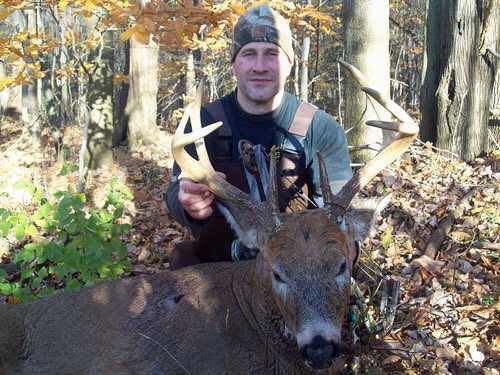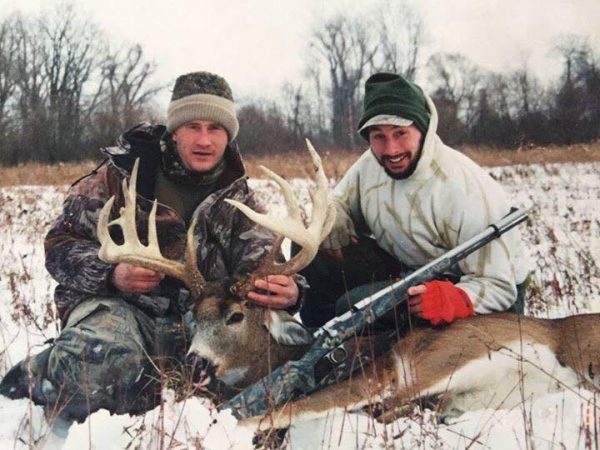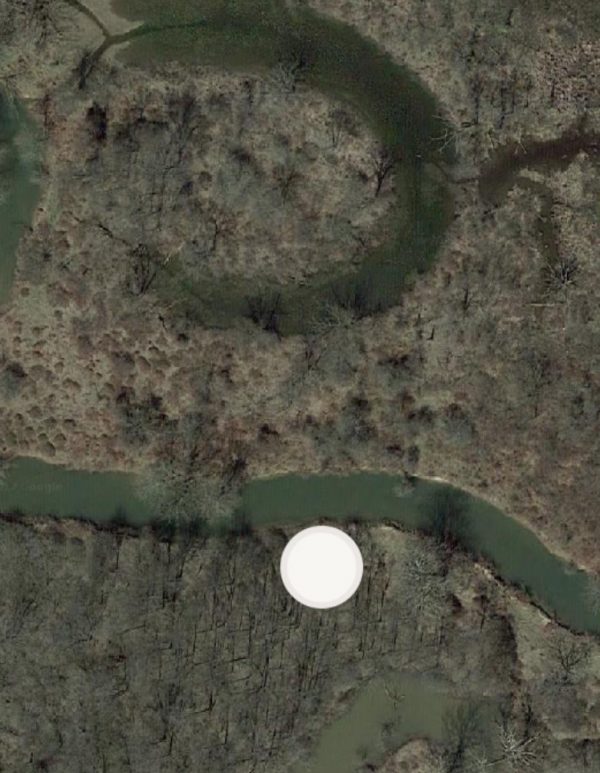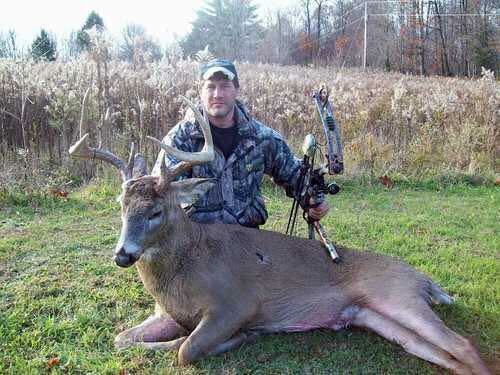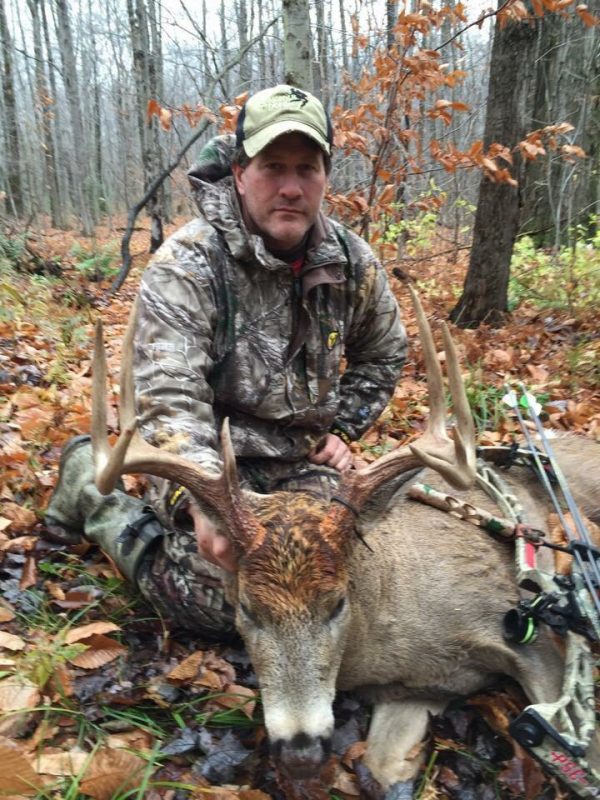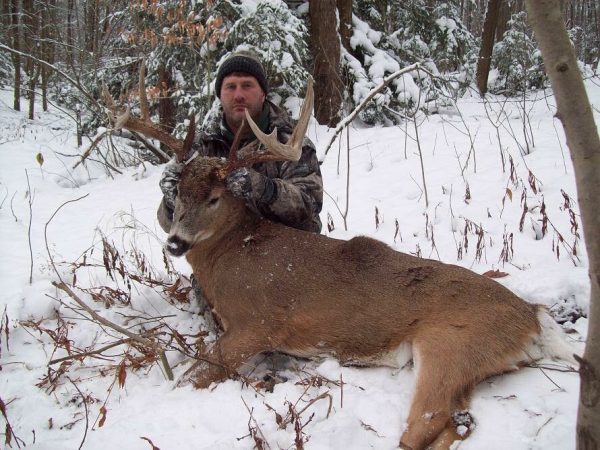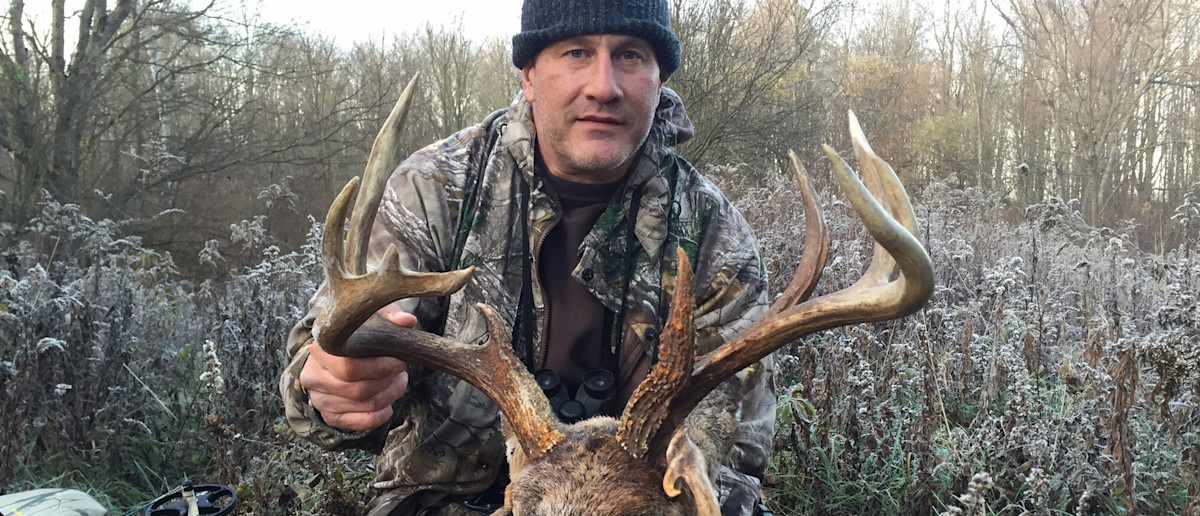
By Andy May
I had heard Mike Perry’s name mentioned a number of times over the past year as a straight up killer, so I did what any man would do and Facebook stalked him! What I ended up finding though was a humble guy with a wealth of whitetail knowledge. You can tell when talking with Mike that he was not spoon fed big bucks – he out-works practically everyone and kills mature deer on heavily pressured lands where almost everyone else fails. He does it the hard way – with hard work, preparation, and persistence. In fact, one of his most effective techniques is tracking big bucks in the snow and killing them in their bed.
When Mike talks, I’m all ears and you should be to.
Q: Tell me a little bit about the places that you hunt.
A: I hunt primarily public land in PA and heavily pressured private land in northeast Ohio. I seek out swamps and marshes in both states. I rarely hunt an area that does not require me to cross water to get to where I want to hunt. I usually wear out a pair of hip waders every year, and I rarely hunt without them on. A lot of public land all over the country is composed of swamp and marsh land. Over the years I’ve learned that the habitat in swamps and marshes provides me the best opportunities to hunt mature bucks.
Q: Looking through your pictures, you have had some incredible success. How did you get into hunting and how did you develop the skills that make you so lethal?
A: I started hunting at the age of 12 back in 1977 with my grandfather and uncles. I spent a lot of my first years of hunting/stalking squirrels with my shotgun while my grandpa bow hunted. I learned how to move slowly through the woods, I learned patience and how to recognize what’s going on around me in the timber like the sounds that birds and animals make when they were alarmed by me.
I was not allowed to deer hunt until I was 16. The first day I hunted deer my uncle shot a buck and I saw a pile of deer. That fueled my fire! I killed a buck the next rifle season and had pretty good success rifle hunting the next couple years. When I turned 21 I got my first compound bow. I had an opportunity at a six point at ten yards that first year. When I drew back I was shaking so bad I made the arrow come off the rest! I was a mess and it was the most exhilarating feeling I’d ever had! It’s cliché but if you could only bottle that feeling you would be rich.
I killed a buck on the first day of archery the next year and I was absolutely thrilled! I didn’t want my season to be over already so I bought my first Ohio non-resident license. I knocked on doors till I got permission and my first night hunting over a scrape in Ohio I had a close encounter with a mature buck. I did not kill him that day but that buck taught me a lot about how smart a mature whitetail is while hunting him my first two seasons in Ohio. I finally killed him in November of the second year and it was on from there on out. The next year I started hunting New York as well. I was obsessed with learning everything I could from the animals. I wanted to know how and why they did what they did on the places I hunted. I started reading every magazine article and book on hunting deer I could find. I started thinking about whitetails 24/7/365. In those early years I learned the importance of scouting, learning the terrain, and how deer used terrain and land features to their advantage. I learned the importance of scouting year round and never being satisfied that I knew enough. I ask myself why are deer doing this or that constantly. I learned from my failures through trial and error. Those first years laid the ground work for the hunter I have become.
Q: What are some of the things you look for or try to do when avoiding the crowds on pressured land?
A: I learned early in my bow hunting career that most hunters don’t like crossing water to get to where the deer are. Your average hunter does not want to cross creeks, maneuver through swamps and over beaver levies in the dark. I found that hunting areas like that gave me the best opportunity to stay away from the crowds and you can usually find the best bucks in the thick swamps away from human intrusion. I’ve found almost any wet areas are usually avoided by hunters and they don’t necessarily have to be far from parking lots. Say you have a big piece of public that is a couple thousand acres. There are most likely going to be some homes that only own a few acres along the roads. If the parking areas are far from these houses most guys feel intimidated asking to park on private land to access the public or they just don’t feel comfortable parking off the road near the homes. That’s a situation where you may not have to go very deep in to have some great hunting all to yourself on public. The deer and especially the mature bucks are going to spend most of their daylight time where they are not being pressured by hunters. Find these spots and you’ll find the deer.
Q: Is there a specific tactic that you feel has led to most of your kills on mature deer?
A: I’ll start by saying that finding buck and doe bedding and being able to tell the difference between the two is probably the single most important factor to consistently killing mature bucks. The tactic that has led to most of my bow kills is hunting on some sort of transition line. The bedding is going to be nearby in most cases and most of the daytime activity is going to happen in this area, especially on public.
I also am looking for stand sites where I can use water as a barrier on at least one side to help funnel deer. The best case would be water on two sides with high ground 40 to 80 yards wide running between the water. Once these stand sites are established and prepared in the spring, I’m staying out of those areas until late October. I have found several areas like this over the years and start hunting them late October and I sit all day dark to dark, several of my best bucks have come between 9-2. I like these areas to be near doe bedding and I’m catching cruising bucks checking those doe bedding areas.
For gun hunting it’s knowing your buck bedding and going in and still hunting those bedding areas or specific buck beds that you found while scouting in the spring. I’ve killed many of my best scoring bucks right in their beds with an in-line muzzleloader. It helps when there is snow tremendously. I’ll find tracks of a mature buck in the snow and I’ll use my best educated guess to anticipate the bedding area or specific bed I think he is heading to after looking at his tracks.
Q: Tell me the main reason, in your opinion, that you have been so successful.
A: Lots of scouting, preparation and hard work, I probably scout two hours for every hour I spend on stand. I’d say scouting through the season and especially right after the season all the way up till summer would be the main reason I’m successful. It helps that I love every minute of it and I can’t get enough. I’m patient and persistent, I hunt from the start of the season until the last day if I’m still holding a tag and I just never give up. I use different tactics during early season, the rut and late season. I hunt many different pieces of property that enable me to not put too much pressure ( by me ) on any one place I hunt.
Q: What pieces of equipment, if any, do you rely on with your style of hunting?
A: Other than the weapon I’m hunting with at the time I rely on my Lone Wolf climber and portable stands and my XOP sticks. I run about 25-30 cameras total on all the properties I hunt, most of which are set up for inventory purposes. On all-day hunts my pack has Gatorade, some food, milkweed to constantly check wind currents, grunt call, bleat can, range finder, knife, folding saw, my license, bear spray and a pull-up rope.
Q: What is the biggest problem with the average hunters watching the “TV Hunters” kill monster buck after monster buck and then trying to apply it in their own areas?
A: It’s an unrealistic situation for the average hunter to control hunting pressure and farm for mature bucks. It gives new hunters unrealistic expatiations. Very few of these shows are teaching you anything about hunting the real world whitetails that most of us are hunting. You have to set realistic goals for the area that you hunt. Too much emphasis is being placed on shooting high scoring bucks these days. New hunters need to just set realistic goals for the deer that live in the areas they are hunting in.
Learning from the animals that they hunt will hone their hunting skills and provide opportunities to learn woodsmanship. To the new hunter or any hunter wanting to learn more about whitetails, I recommend joining The Hunting Beast forum. There are a bunch of very knowledgeable guys on there who are willing to share a wealth of very valuable hunting information. I also highly recommend the owner of the Hunting Beast Dan Infalt’s scouting dvds. I’ve been at this 31 years and I’m still learning. I’ve found this forum and Dan’s DVDs to be the most educational stuff out there on deer hunting and scouting tactics.
Q: Early Season, Mid October, Late October, Early/mid November, Late November, December/late season. Pick your two favorites and tell me how you’re hunting them.
A: Early to mid November has been my favorite time to hunt rutting bucks and I’ve taken a lot of mature bucks between November 2-14. This time of year I’m going to key in on doe bedding areas. I’m going to be hunting my best stand sites for the first time all season and these stands will be near doe bedding. Some of my best stands will use water as a barrier to funnel cruising bucks past me. I will typically be able to approach these stands undetected from the other side of a creek or river and set my stand near the bank, never having to cross any of the trails. I’m going to sit there all day long because I know through my scouting that I’m in the best spot. Through scouting I’m going to have a realistic expectation of what kind of bucks are in the area too. While sitting there I’m visualizing a mature buck walking up to me and go over what moves I’ll make when the shot presents itself. I don’t like to blind call. The only time I would call is if I identify a buck I want to shoot that is not coming my way. I’m going to be checking the wind currents constantly with milk weed. I’m usually hunting mobile, so if the currents change for the worse I can move to another tree or another area. I’m going to leave as carefully and as quietly as I got there.
The next would be December because around here that’s gun season. I love gun season because it’s the only time all year I hunt with my friends. We put on deer drives and kill some great bucks and a bunch of does. The guys I hunt with are the best hunters I know of and some of the best shots you’ll ever meet. It’s time to make memories and fill the freezer. When I’m not hunting with them I love still-hunting in the snow with my in-line muzzleloader on big public areas. I’ll cut through an area until I come across a mature buck’s track and I’ll try to track him down or I’ll make an educated guess as to what bedding area or specific buck bed I think he headed to. I’ve shot six mature bucks still-hunting. Five of them were lying in their beds when I shot them. One of these bucks was only 25 yards away before I saw him and none were over 80 yards, so it’s close quarters action. It seems the biggest bucks stay put, hiding in the thick brush and watch you pass by. I’ve also killed a bunch of does still-hunting. It’s a rush!
Q: Where do you think the average guy fails at consistently killing mature bucks every year?
A: Lack of preparation. If you want to consistently kill mature bucks on public or pressured land you’ll have to be prepared and that means scouting post-season. The thing I see most hunters do wrong on pressured land is setting up over all the hot sign and usually right on top of it. This sign is usually made at night. In fact I could care less if there is buck sign around my stand sites. If it’s there it’s a bonus, but I’m not hunting buck sign like rubs and scrapes because most of that sign is made at night, especially on pressured land. To me it seems like common sense that if land is pressured by hunters and deer are nocturnal animals by nature, the sign near fields is made during the night. Find the bedding and you’ll have a chance. Hunt a bunch of scrapes on the edge of a field on public or heavily pressured land and chances are pretty slim you even have any chance to kill a mature buck.
Q: Give one tip/secret for the readers that you think will improve their game on mature bucks.
A: Something I started doing about eight years ago is finding a few new areas that look like they would be great rut setups. Again I’m usually using water as a barrier in my rut setups. I hang a camera in these areas and leave it there undisturbed all season long from October through the gun season. I never hunt that area all season. What I’m looking for is evidence of mature bucks using that area during the day.
I’ve found over the years that a particular buck seems to do the same thing from one season to the next or he at least uses that same area during the same timeframe from season to season. If I get pictures of a mature buck using that area during daylight on my test year I’ll set up and hunt that area in that same timeframe the following year. This helped me kill the buck I harvested this past season in Ohio. I had a camera all through the 2015 season on this buck in an area of the farm I was not hunting. He moved through this transition line on the edge of this beaver swamp twice during daylight in the first two weeks of November in 2015. I killed him there in the same exact timeframe in 2016. I am guessing these mature bucks are keying in on certain areas in the same time frame every year because I believe certain doe groups come into estrus at the same time every year.

